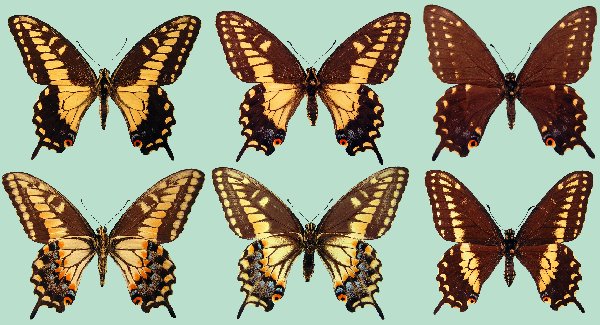Papilio coloro

Photo Life History: Papilio coloro
Habitat: Desert Hills & Mountains
Host Plants: Thamnosma montana, Lomatium parryi
Suitable Lab Host Plants: Foeniculum vulgare, Anathem graveolens, Ruta graveolens
Caring for Live Female Butterflies: Feed females regularly.
Methods of Female Oviposition: Open Screen Cages
How to Find Eggs: Look on hostplants with new growth. (Thamnosma montana new growth.)
How to Hatch Eggs: Consolidate eggs into one container
How to Find Caterpillars in the Field: Look on plants about 1 month after their main flight. You can usually find larvae in large numbers if you look in the spring following a very wet winter.
Caterpillar setups: Open terrariums; Open Bucket
Larva to Pupa: Larva purges and wanders
How to Find Pupae in the Field:
Number of Broods per Year: 1-4 depending upon location.
Overwintering Stage: Pupa. Also, Col. Clyde Gillette also documented and proved that last instar larvae can successfully overwinter and resume feeding in the spring when host plants dry up in the late fall.
Overwintering Stage: Pupa.
Overwintering Strategies: Your Own Backyard; Refrigerator
Post-Hibernation Strategies: Expose pupae to warmer temperatures, long-day photoperiod; and mist spraying. Pupae should emerge within a couple of weeks.
Avoiding Diapause Techniques: Healthy Host Plant; Expose larvae to 24 hours of light. Mist spray pupae.
Disease Prevention: Change out host plant and remove frass every four to six days using the open bucket or open terrarium techniques.
Emergence: Emergence Container
Field Notes: Adult abundance is greatly determined by sufficient and timely winter moisture. The best plants to find larvae on are those growing on the shoulder of the road or other places where the road was bulldozed; stimulating fresh growth (or germination) of the plants. Due to run-off, available moisture is much greater here, resulting in the new growth on which the females love to oviposit. To be sure of getting both color forms of adults, getting ova from females is best. Since Thamnosma plants do not have much food growing on them, the lab hosts are preferable for rearing. In Utah, black adults (form clarki) seem to increase in abundance during the summer months. They are never common in Utah. Spring flights near the Dead Mountains, San Bernardino County, California, show an approximate 4:1 ratio of forms coloro to clarki.

